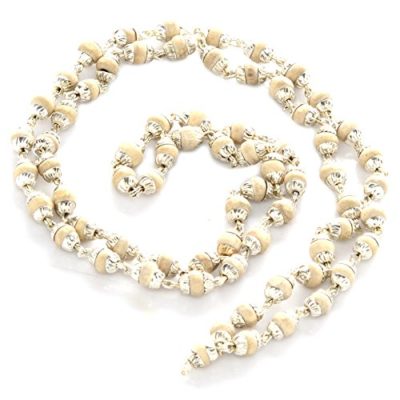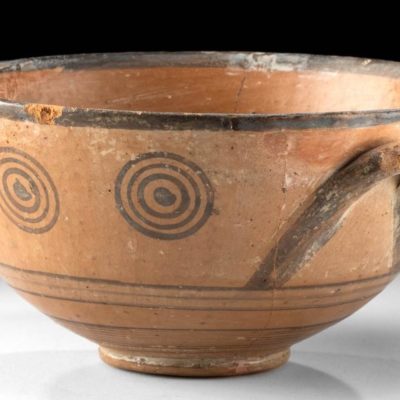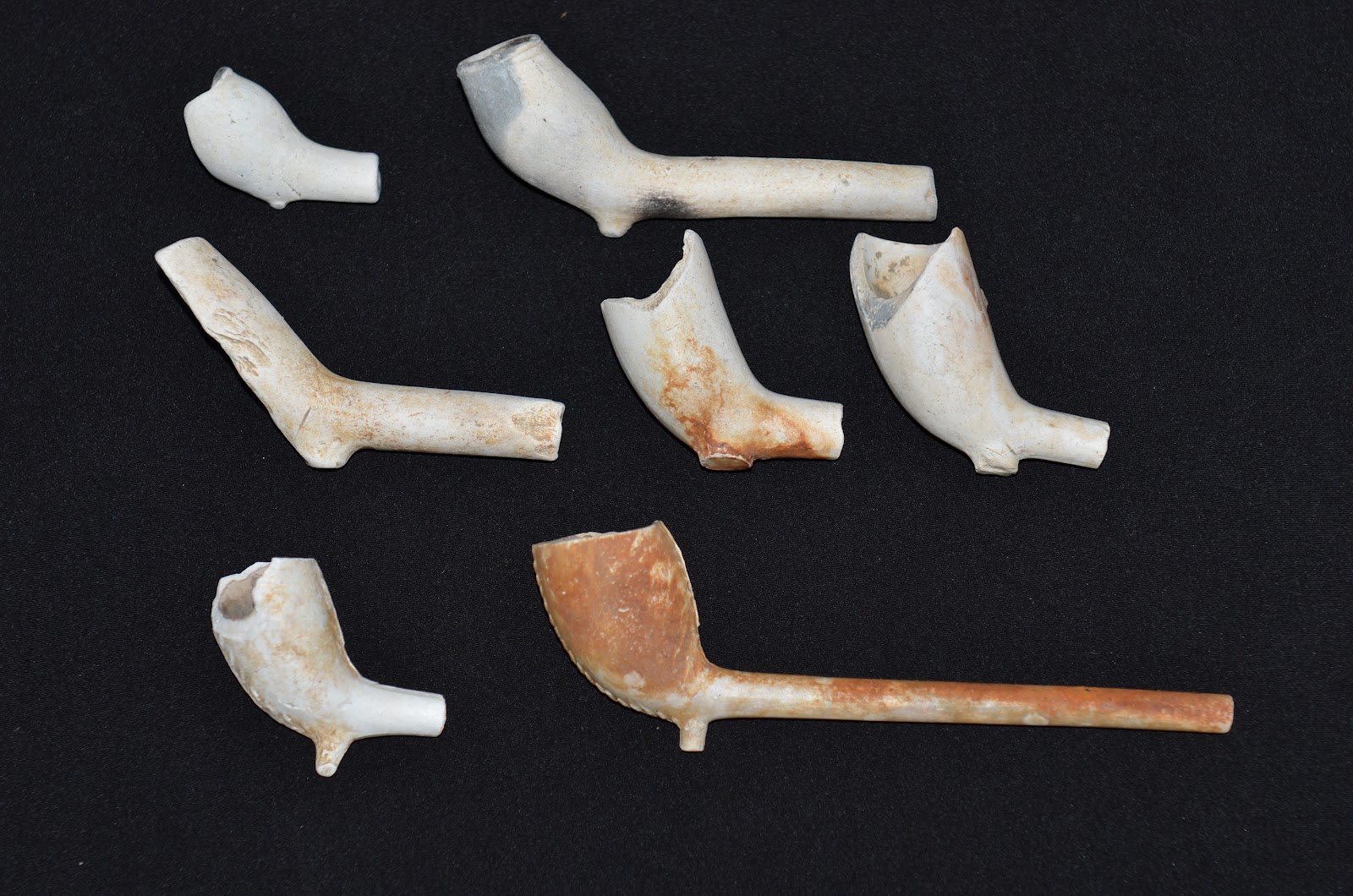The American Indians of the Proto-Historic through the Historic Periods (AD 1500-1750) made and used pipes for smoking tobacco and herbs. Most of these Indian pipes were simple and plain in appearance, were of the elbow type and were made of locally made and fired tan to black ceramics. When the English and Scots began exploring the Piedmont shortly after AD 1600, they brought with them European made ceramic pipes to trade with the natives for deer skins and land. Almost all of these trade pipes were made of white kaolin clay and were also the small and plain elbow types. Sometime during the period of AD 1600 and 1650, the Europeans began making more decorative pipes for trading purposes and someone, probably in Holland or England, decided to decorate some of these white trade pipes with a clock or watch gear thus producing indented images on the pipe surfaces in the process known as rouletting. This is where a small toothed wheel, often attached to a handle, is used for making rows of dots or punctations, usually on a softer matrix. Possibly at least one of these pipes was traded to an Indian who lived in the Upper Sauratown village in Stokes County, North Carolina. Did that native (or a pipe making artisan in the village) copy this trade pipe and with, maybe, an acquired clock gear make this unusual rouletted smoking instrument or does the Indian made pipe date to an earlier time period?

This pipe is dark brown to black in color and is native made of crushed quartz or fine sand tempered and polished ceramics. It is 3 5/8 inches long with an unknown amount of the stem being broken, either anciently or by modern farming equipment. The simple architecture and material of the pipe is typical of the elbow pipes made by the natives in the Piedmont during that period and it has an inherent classical shape and beauty onto itself. And then there is the decoration. The bowl of the pipe is incised with double rings around the rim and near the base just above the stem. Actually they are not incised rings but are, in fact, a series of tiny dots spaced less than a 1/64 inch apart. These dots are really dentates or punctates pressed into the green (unfired) clay before the pipe was seasoned in hot coals. These piercings on the pipe are so tiny and closely spaced that the appearance is of solid engraved lines. But the pipe maker was not finished. On each side of the bowl are punctated double lightning symbols ending in small circles at the top and bottom. The side of the bowl that faces the smoker has an eight pointed star and the front of the bowl has the most unusual decoration on the pipe. It is difficult to discern just what the artist was attempting to do with this odd symbol. It was perhaps intended to be a human figure with two feathers attached to the head. Or was the pipe maker simulating an insect such as a grasshopper or maybe some mythical being? These motifs may have some relationship to the celestial deities called the “Thunderers” and “Morning Star” of the more ancient (AD 1000-1500) Mississippian Period. After the pipe was fired, someone rubbed a white substance (a crushed kaolin pipe?) into all the dentates so they would stand out against the dark ceramics. The Indians of the Virginia and Carolina coastal regions did make pipes with rouletted designs in the seventeenth century (and probably before that time) and there have been numerous European made pipes with this type decoration found in that region. Today there are strong speculations that the prehistoric coastal Indians made roulette style decorations on pipes using small serrated shark teeth and/or scallop shells since pipes that probably pre-date the Roanoke Island colony (AD 1584) have been found. Possibly the early European explorers saw these pipes and copied the Indian designs using clock gears. Many of these coastal trade and native made pipes have triangles, running deer and simple vertical and horizontal lines as roulette type motifs and a very few Piedmont Indian made roulette adorned pipes have been found with the same decorations as the coastal examples. The star, lightning and the strange man/insect/deity figure, though, are unique to this pipe. The writer has seen and examined hundreds Indian and European made pipes of the Prehistoric to Historic Periods but has never seen another Piedmont aborigine made pipe with these designs of roulette ornamentation. The question remains as to whether this pipe was made at the Upper Sauratown site during its occupation (AD 1600-1700) or was it made and decorated in prehistoric times. The writer believes, because of the white (probable powdered kaolin pipe) substance rubbed into the dentates, that this pipe was Indian made during the Sauratown occupation but whether a clock gear or a serrated shark tooth was used is uncertain. Since these decorations will be difficult to see in the photo, drawings of them are shown with this article.

Today, being three hundred plus years since this artifact was made, we will probably never be able to decipher exactly what the pipe maker was intending to show with this artwork. The decorations were obviously not needed for the pipe to function as a smoking instrument but for some artistic/ceremonial/religious reason, the craftsman wanted to show his or her talents with a circular clock gear or a shark tooth and produced this unusual, and perhaps one of a kind, rouleltted Piedmont NC pipe.
REFERENCES:
Dye, David H.
“Art, Ritual, and Chiefly Warfare in the Mississippian World”,
HERO, HAWK, AND OPEN HAND
2004
Egloff, Keith
“Colonial Pipes of Virginia”, NOTES ON VIRGINIA – VIRGINIA
DEPARTMENT OF HISTORIC RESOURCES
2005
Green, Paul R.
THE ARCHAEOLOGY OF 31HY43 “POMEIOOC”
1987
Haag, William G.
“The Archaeology of Coastal North Carolina”, LOUSIANA STATE UNIVERSITY STUDIES
1958
Reilly, F. Kent and James E. Garber
ANCIENT OBJECTS AND SACRED REALMS
2007
Ward, H. Trawick and R. P. Stephen Davis, Jr.
INDIAN COMMUNITIES OF THE NORTH CAROLINA PIEDMONT A. D. 1000 TO 1700
1993





